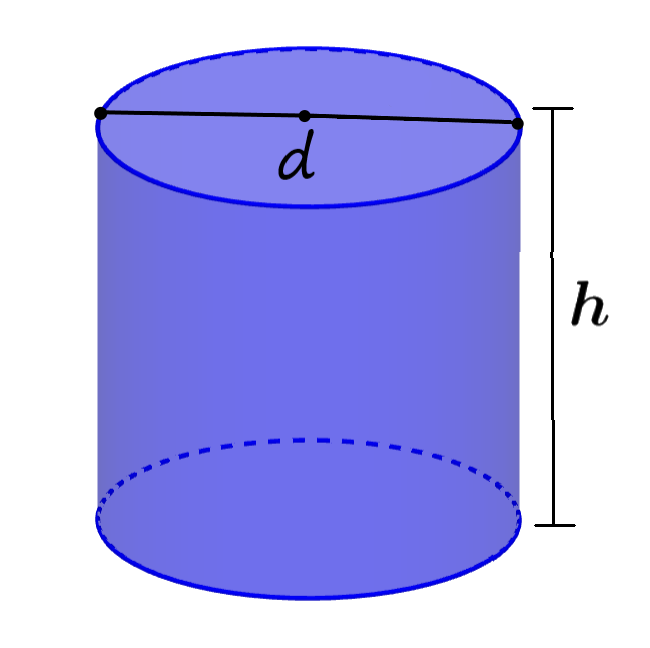The diameter of a cylinder is equal to the longest length that can be located on the circular bases and that passes through the center of the circles. Along with the radius, the diameter is often used to calculate the volume and the surface area of a cylinder. Similarly, it is also possible to find the length of the diameter if we know the volume or the surface area of the cylinder.
Here, we will learn about the three different methods that we can use to calculate the length of the diameter of a cylinder. In addition, we will look at some exercises in which we will apply these formulas.
Diameter of a cylinder using the radius
Radius, along with height, is the most common dimension of a cylinder. Therefore, many times we will know the length of the radius of the cylinder. If we know the radius, we can calculate the diameter easily, we simply have to multiply the radius by 2.
Therefore, if we want to find the length of the diameter using the length of the radius, we use the following expression:
$latex d=2r$
EXAMPLE 1
What is the diameter of a cylinder that has a radius of 5 m?
Solution: We use the formula given above with the length $latex r=5$. Therefore, we have:
$latex d=2r$
$latex d=2(5)$
$latex d=10$
The diameter is 10 m.
EXAMPLE 2
If a cylinder has a radius of 23 m, what is its diameter?
Solution: We have the length $latex r=23$. Therefore, using this value in the formula, we have:
$latex d=2r$
$latex d=2(23)$
$latex d=46$
The diameter measures 46 m.
Diameter of a cylinder using volume
We can find the value of the diameter starting from the volume. Recall that the formula for the volume of a cylinder is:
$latex V=\pi {{r}^2}h$
or in terms of the diameter, it is:
$latex V=\pi \frac{{{d}^2}}{4}h$
Therefore, we can use this formula and solve for the diameter if we have the values for the volume and the height.
EXAMPLE 1
What is the diameter of a cylinder that has a volume of 100 m and a height of 8 m?
Solution: We have the values $latex V=100$ and $latex h = 8$. Therefore, we use the volume formula, plug in the given values, and solve for d:
$latex V=\pi \frac{{{d}^2}}{4}h$
$latex 100=\pi \frac{{{d}^2}}{4}(8)$
$latex {{d}^2}=\frac{4(100)}{8\pi}$
$latex {{d}^2}=\frac{400}{8\pi}$
$latex {{d}^2}=15.92$
$latex d\approx 4$
The diameter is 4 m.
EXAMPLE 2
A cylinder has a volume of 240 m and a height of 12 m. What is its diameter?
Solution: We have the values $latex V=240$ and $latex h=12$. Therefore, we can use the volume formula and solve for d:
$latex V=\pi \frac{{{d}^2}}{4}h$
$latex 240=\pi \frac{{{d}^2}}{4}(12)$
$latex {{d}^2}=\frac{4(240)}{12\pi}$
$latex {{d}^2}=\frac{960}{12\pi}$
$latex {{d}^2}=25.46$
$latex d\approx 5.05$
The diameter measures 5.05 m.
Diameter of a cylinder using surface area
The surface area can also be used to find the diameter of a cylinder. Similar to the previous examples, we need to know the value of the surface area and the length of the height to determine the diameter. Recall that the formula for the surface area is:
$latex A_{s}=2\pi {{r}^2}+2\pi rh$
or in terms of the diameter, we have:
$latex A_{s}=\pi (\frac{{{d}^2}}{2})+\pi dh$
EXAMPLE 1
What is the diameter of a cylinder that has a surface area of 100 m and a height of 4 m?
Solution: We have the values $latex A_{s}=100$ and $latex h=4$. Therefore, we have:
$latex A_{s}=\pi (\frac{{{d}^2}}{2})+\pi dh$
$latex 100=\pi (\frac{{{d}^2}}{2})+4\pi d$
$latex 100=1.57{{d}^2}+12.57 d$
$latex 1.57{{d}^2}+12.57 d-100=0$
We see that we obtained a quadratic equation. We can use the quadratic formula to find the result:
$latex x=\frac{{-b\pm \sqrt{{{{b}^{2}}-4ac}}}}{{2a}}$
$latex x=\frac{{-12.57\pm \sqrt{{{{12.57}^{2}}-4(1.57)(-100)}}}}{{2(1.57)}}$
$latex x=4.93,~~x=-12.93$
A quadratic equation generally has two solutions, that is why we have two values of x. However, we see that a value is negative and it makes no sense to have a negative diameter, so we only consider the positive answer. The diameter of the cylinder measures 4.93 m.
EXAMPLE 2
If a cylinder has a surface area of 240 m and a height of 10 m, what is its diameter?
Solution: We have the values $latex A_{s}=240$ and $latex h=10$. Therefore, we have:
$latex A_{s}=\pi (\frac{{{d}^2}}{2})+\pi dh$
$latex 240=\pi (\frac{{{d}^2}}{2})+10\pi d$
$latex 240=1.57{{d}^2}+31.42 d$
$latex 1.57{{d}^2}+31.42 d-240=0$
We solve the quadratic using the quadratic formula:
$latex x=\frac{{-b\pm \sqrt{{{{b}^{2}}-4ac}}}}{{2a}}$
$latex x=\frac{{-31.42\pm \sqrt{{{{31.42}^{2}}-4(1.57)(-240)}}}}{{2(1.57)}}$
$latex x=5.9,~~x=-25.9$
We only consider the positive solution since it does not make sense to have a negative diameter. The diameter of the cylinder measures 5.9 m.
See also
Interested in learning more about cylinders? Take a look at these pages:




